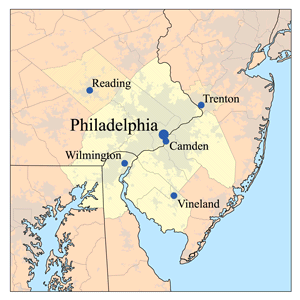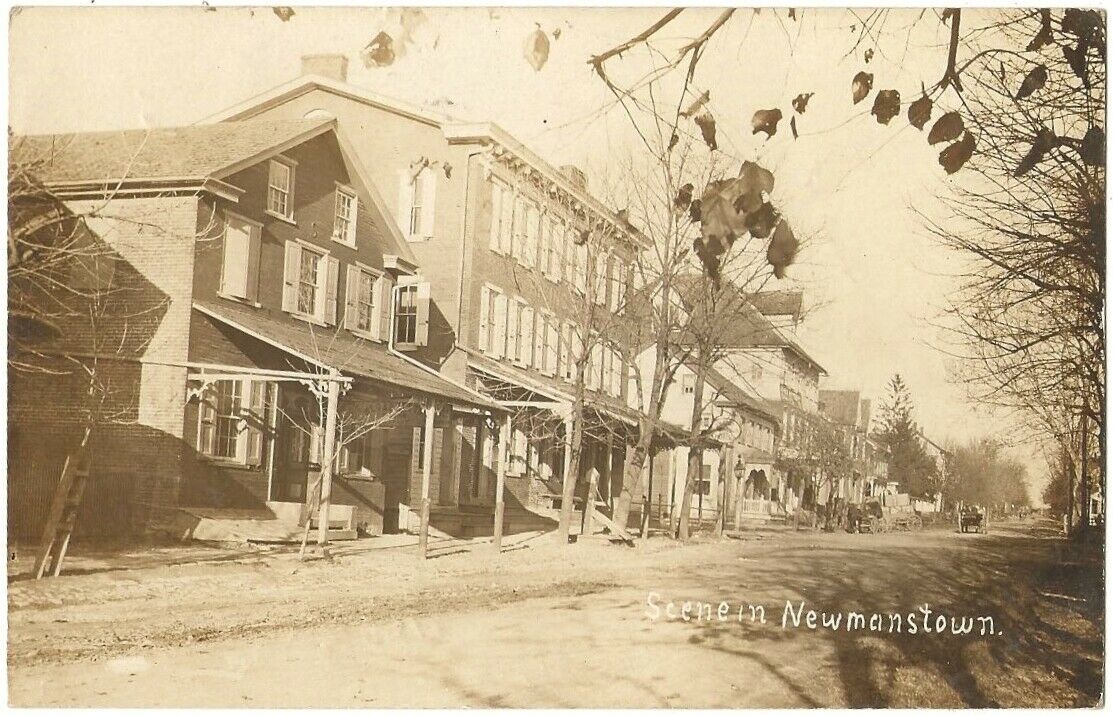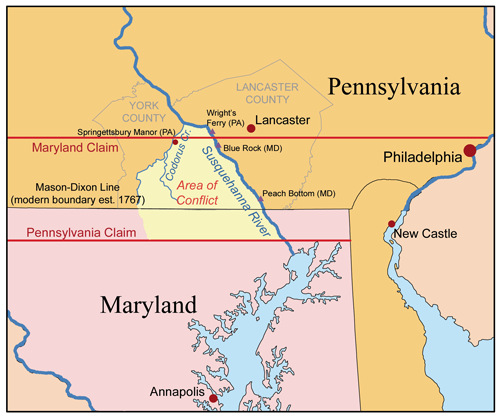|
Area Codes 610, 484, And 835
Area codes 610, 484, and 835 are telephone area codes in the North American Numbering Plan (NANP) for the eastern and southeastern regions of Pennsylvania. The numbering plan area (NPA) includes regions to the west of Philadelphia and the cities Allentown, Bethlehem, and Reading. It includes much of the Delaware Valley, including almost all of Delaware County, most of the Philadelphia Main Line, and all of the Lehigh Valley. History Area code 610 was created on January 8, 1994 as a split from numbering plan area 215, which had been the entire southeast quadrant of Pennsylvania since 1947. Permissive dialing of both 215 and 610 continued until the morning of January 7, 1995. It was Pennsylvania's first new area code since the implementation of the area code system in 1947. Three exchanges which would have switched to 610 were instead switched to 717, the area code for most of the eastern half of the state outside of the lower Delaware and Lehigh Valleys. They were 267 at Denver ... [...More Info...] [...Related Items...] OR: [Wikipedia] [Google] [Baidu] |
Area Code
A telephone numbering plan is a type of numbering scheme used in telecommunication to assign telephone numbers to subscriber telephones or other telephony endpoints. Telephone numbers are the addresses of participants in a telephone network, reachable by a system of destination code routing. Telephone numbering plans are defined in each of the administrative regions of the public switched telephone network (PSTN) and in private telephone networks. For public numbering systems, geographic location typically plays a role in the sequence of numbers assigned to each telephone subscriber. Many numbering plan administrators subdivide their territory of service into geographic regions designated by a prefix, often called an area code or city code, which is a set of digits forming the most-significant part of the dialing sequence to reach a telephone subscriber. Numbering plans may follow a variety of design strategies which have often arisen from the historical evolution of individual ... [...More Info...] [...Related Items...] OR: [Wikipedia] [Google] [Baidu] |
Berks County, Pennsylvania
Berks County ( Pennsylvania German: ''Barricks Kaundi'') is a county in the Commonwealth of Pennsylvania. As of the 2020 census, the population was 428,849. The county seat is Reading. The Schuylkill River, a tributary of the Delaware River, flows through Berks County. The county is part of the Reading, PA metropolitan statistical area (MSA), which is included in the Philadelphia-Reading- Camden, PA- NJ- DE- MD combined statistical area (CSA). History Reading developed during the 1740s when inhabitants of northern Lancaster County sent several petitions requesting that a separate county be established. With the help of German immigrant Conrad Weiser, the county was formed on March 11, 1752, from parts of Chester County, Lancaster County, and Philadelphia County. It was named after the English county in which William Penn's family home lay, Berkshire, which is often abbreviated to Berks. Berks County began much larger than it is today. The northwestern parts of the ... [...More Info...] [...Related Items...] OR: [Wikipedia] [Google] [Baidu] |
Lehigh County, Pennsylvania
Lehigh County (Pennsylvania Dutch: ''Lechaa Kaundi'') is a county in the Commonwealth of Pennsylvania. As of the 2020 census, the county's population was 374,557.Lehigh County at U.S. Census Quick Facts Its county seat is , the state's third largest city after and . Lehigh County and [...More Info...] [...Related Items...] OR: [Wikipedia] [Google] [Baidu] |
Newmanstown, Pennsylvania
Newmanstown is an unincorporated community and census-designated place (CDP) in Millcreek Township, Lebanon County, Pennsylvania. The population was 2,478 at the 2010 census, an increase over the figure of 1,536 tabulated in 2000. Geography Newmanstown is in southeastern Lebanon County along the northeastern edge of Millcreek Township. It is bordered to the northeast by Marion Township and Heidelberg Township in Berks County. Route 419 runs through the center of town as Main Street, leading northeast to Womelsdorf and southwest to Schaefferstown. Lebanon, the county seat, is to the west of Newmanstown, and Reading is to the east. According to the United States Census Bureau, the Newmanstown CDP has a total area of , all land. Mill Creek, which drains northward into Tulpehocken Creek, a tributary of the Schuylkill River, runs along the west side of the town. Demographics As of the 2000 census, there were 1,536 people, 603 households, and 417 families residing in the ... [...More Info...] [...Related Items...] OR: [Wikipedia] [Google] [Baidu] |
Lebanon County, Pennsylvania
Lebanon County ( Pennsylvania Dutch: Lebanon Kaundi) is a county in the Commonwealth of Pennsylvania. As of the 2010 census, the population was 133,568. Its county seat is the city of Lebanon. The county was formed from portions of Dauphin and Lancaster counties in 1813, with minor boundary revisions in 1814 and 1821. Lebanon County comprises the Lebanon, Pennsylvania, metropolitan statistical, which is part of the Harrisburg–York–Lebanon combined statistical area. Lebanon is 72 miles northwest of Philadelphia, which is the nearest major city. Geography According to the U.S. Census Bureau, the county has a total area of , of which is land and (0.2%) is water. Most of it is drained by the Swatara Creek into the Susquehanna River while some eastern portions are drained by the Tulpehocken Creek (which originates in the county near Myerstown) eastward into the Schuylkill River. It consists in large part of a valley. Climate The county has a hot-summer humid contine ... [...More Info...] [...Related Items...] OR: [Wikipedia] [Google] [Baidu] |
Christiana, Pennsylvania
Christiana is a borough (Pennsylvania), borough in Lancaster County, Pennsylvania, United States. The population was 1,100 at the 2020 census. In 1851. it was the site of the Lancaster County, Pennsylvania#Slavery and the Christiana incident, Battle of Christiana, also called the Christiana riot. Geography Christiana is located in eastern Lancaster County at (39.955262, -75.996208). It is bordered to the north, west, and south by Sadsbury Township, Lancaster County, Pennsylvania, Sadsbury Township and to the east by West Sadsbury Township, Chester County, Pennsylvania, West Sadsbury Township in Chester County, Pennsylvania, Chester County. Pennsylvania Route 372 passes through the center of the borough, leading east to Parkesburg, Pennsylvania, Parkesburg and west to Quarryville, Pennsylvania, Quarryville. Lancaster, Pennsylvania, Lancaster is to the northwest via Pennsylvania Route 41, and U.S. Route 30. According to the United States Census Bureau, U.S. Census Bureau, the ... [...More Info...] [...Related Items...] OR: [Wikipedia] [Google] [Baidu] |
Lancaster County, Pennsylvania
Lancaster County (; Pennsylvania Dutch: Lengeschder Kaundi), sometimes nicknamed the Garden Spot of America or Pennsylvania Dutch Country, is a county in the Commonwealth of Pennsylvania. It is located in the south central part of Pennsylvania. As of the 2020 census, the population was 552,984. Its county seat is Lancaster. Lancaster County comprises the Lancaster, Pennsylvania metropolitan statistical area. Lancaster County is a tourist destination with its Amish community a major attraction. Contrary to popular belief, the word "Dutch" in "Pennsylvania Dutch" is not a mistranslation, but rather a corruption of the Pennsylvania German endonym ''Deitsch'', which means "Pennsylvania Dutch / German" or "German". Ultimately, the terms Deitsch, Dutch, Diets, and Deutsch are all cognates of the Proto-Germanic word meaning "popular" or "of the people". The continued use of "Dutch" instead of "German" was strengthened by the Pennsylvania Dutch in the 19th century as a way of distin ... [...More Info...] [...Related Items...] OR: [Wikipedia] [Google] [Baidu] |
Gap, Pennsylvania
Gap is a census-designated place (CDP) and unincorporated community in Salisbury Township, Lancaster County, Pennsylvania, United States, with a ZIP code of 17527. The population was 1,931 at the 2010 census. U.S. Route 30 passes through the town, which is also the terminus for four Pennsylvania highways: 772, 741, 897, and the heavily used 41, which goes toward Wilmington, Delaware. Gap lies approximately east of Lancaster and west of Philadelphia. History Gap was named for its location at a low pass through Mine Ridge. Gap has a history which can be dated as far back as William Penn's first visits to the area. Isaac Taylor erected the first house in what would become Gap in 1747. The area around Gap had a copper mine and what at the time were the only nickel mines in the United States. From 1792, the Rising Sun Tavern stood on the Philadelphia–Lancaster Pike (which is now U.S. Route 30) and had a small village with blacksmith shop. Most of the buildings stood until cir ... [...More Info...] [...Related Items...] OR: [Wikipedia] [Google] [Baidu] |
Chester County, Pennsylvania
Chester County (Pennsylvania Dutch language, Pennsylvania Dutch: ''Tscheschter Kaundi''), colloquially known as Chesco, is a County (United States), county in the Commonwealth (U.S. state), Commonwealth of Pennsylvania. It is located in the Delaware Valley region of the state. As of the 2020 United States census, 2020 census, the population was 534,413, increasing by 7.1% from 498,886 in 2010 United States census, 2010. The county seat and most populated municipality is West Chester, Pennsylvania, West Chester. Chester County was one of the three original Pennsylvania counties created by William Penn in 1682. It was named for Chester, England. Chester County is part of the Philadelphia-Camden, New Jersey, Camden-Wilmington, Delaware, Wilmington, PA-New Jersey, NJ-Delaware, DE-Maryland, MD Delaware Valley, Metropolitan Statistical Area. Eastern Chester County is home to many communities that comprise part of the Philadelphia Main Line western suburbs outside of Philadelphia, whi ... [...More Info...] [...Related Items...] OR: [Wikipedia] [Google] [Baidu] |
Nockamixon Township, Pennsylvania
Nockamixon Township is a Township (Pennsylvania), township in Bucks County, Pennsylvania, Bucks County, Pennsylvania, United States. The population was 3,441 at the 2010 United States Census, 2010 census. Geography According to the United States Census Bureau, the township has a total area of 22.6 square miles (58.5 km), of which 22.2 square miles (57.5 km) is land and 0.4 square mile (1.0 km) (1.73%) is water. It is drained by the Delaware River, which separates it from New Jersey. The township's villages include Bucksville, Fehrtown, Ferndale, Bucks County, Pennsylvania, Ferndale, Frogtown, Harrow, Pennsylvania, Harrow, Kintnersville, Pennsylvania, Kintnersville (also in Durham Township), and Revere, Pennsylvania, Revere.MacReynolds, George, ''Place Names in Bucks County, Pennsylvania'', Doylestown, Bucks County Historical Society, Doylestown, PA, 1942, P1. Natural features include Beaver Creek, Cauffman Hill, Gallows Hill, Gallows Run, Haycock Cr ... [...More Info...] [...Related Items...] OR: [Wikipedia] [Google] [Baidu] |
Riegelsville, Pennsylvania
Riegelsville is a borough in Bucks County, Pennsylvania, Bucks County, Pennsylvania, United States. The population was 868 at the 2010 census. It is included in the Delaware Valley, Philadelphia-Wilmington-Camden Metropolitan Statistical Area, despite being so closely connected to the Lehigh Valley. History Benjamin Riegel founded Riegelsville. The original, and now historicRiegelsville Innthat he built in 1838 still stands. This historic stone inn has offered food and lodging to Bucks County travelers for over 160 years. The community was named for the Riegel family, as early landowners; they established paper mills across the river in New Jersey. The pictured "Riegelsville Hotel" is in Riegelsville, Pa. With the completion of the Delaware Canal in 1832, the lands along the Delaware River attracted great industrial development. The movement of coal, a major important product of the area, brought capital & investment to Easton. Boats carried coal, stone, iron, crops, and goods f ... [...More Info...] [...Related Items...] OR: [Wikipedia] [Google] [Baidu] |
Springfield Township, Bucks County, Pennsylvania
Springfield Township is a township in Bucks County, Pennsylvania. The population was 5,035 at the 2010 census. History The Jacob Funk House and Barn, John Eakin Farm, Knecht's Mill Covered Bridge, Springhouse Farm, and Springtown Historic District are listed on the National Register of Historic Places. It was also the location of the formerly listedU.S. Census Bureau, the township has a total area of 30.8 square miles (79.7 km2), all land. It is located in the Delaware watershed and, while most of the township is drained directly eastward into the Delaware River by Tohickon Creek and Cooks Creek (both of which start in Springfield,) a very small area in the extreme west is drained by the Unami Creek into the Perkiomen Creek and Schuylkill River. Springfield Township's past and present villages include Bursonville, Gallows, Gruversville, Hilltop, Passer, Pleasant Valley, Bucks County, Pennsylvania, Pleasant Valley, Pullen, Springtown, Stony Point, and Zionhill ... [...More Info...] [...Related Items...] OR: [Wikipedia] [Google] [Baidu] |



